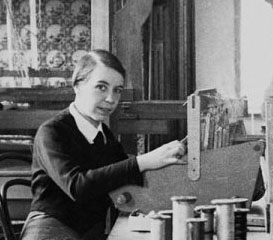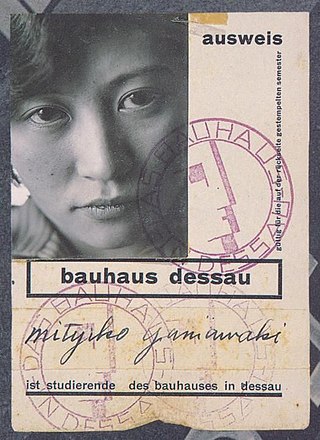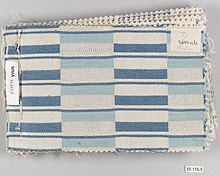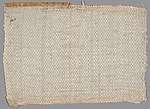
Weaving is a method of textile production in which two distinct sets of yarns or threads are interlaced at right angles to form a fabric or cloth. Other methods are knitting, crocheting, felting, and braiding or plaiting. The longitudinal threads are called the warp and the lateral threads are the weft, woof, or filling. The method in which these threads are interwoven affects the characteristics of the cloth. Cloth is usually woven on a loom, a device that holds the warp threads in place while filling threads are woven through them. A fabric band that meets this definition of cloth can also be made using other methods, including tablet weaving, back strap loom, or other techniques that can be done without looms.

Anni Albers was a German-Jewish visual artist and printmaker. A leading textile artist of the 20th century, she is credited with blurring the lines between traditional craft and art. Born in Berlin in 1899, Fleischmann initially studied under impressionist painter Martin Brandenburg from 1916 to 1919 and briefly attended the Kunstgewerbeschule in Hamburg in 1919. She later enrolled at the Bauhaus, an avant-garde art and architecture school founded by Walter Gropius in Weimar in 1922, where she began exploring weaving after facing restrictions in other disciplines due to gender biases at the institution.

Gunta Stölzl was a German textile artist who played a fundamental role in the development of the Bauhaus school's weaving workshop, where she created enormous change as it transitioned from individual pictorial works to modern industrial designs. She was one of a small number of female teachers on the Bauhaus' staff and the first to hold the title of "Master".

Dorothy Wright Liebes was an American textile designer and weaver renowned for her innovative, custom-designed modern fabrics for architects and interior designers. She was known as "the mother of modern weaving".

Trude Guermonprez, was a German-born American textile artist, designer and educator, known for her tapestry landscapes. Her Bauhaus-influenced disciplined abstraction for hand woven textiles greatly contributed to the American craft and fiber art movements of the 1950s, 60s and even into the 70s, particularly during her tenure at the California College of Arts and Crafts.

Gertrud Arndt was a German photographer and designer associated with the Bauhaus movement. She is remembered for her pioneering series of self-portraits from around 1930.

Tibor Reich ATI, FSIA, FRSA was a British textile designer. His company, Tibor Ltd., produced designs featured in projects including the Festival of Britain, Concorde, Royal Yacht Britannia, Coventry Cathedral, Clarence House and the QE2. Reich was awarded a Design Council Award in 1957 and a Textile Institute Medal in 1973.

Charlotte Ida Anna "Lotte" Stam-Beese was a German-Dutch architect, photographer and urban planner who helped with the reconstruction of Rotterdam after World War II.
Ivana Tomljenović-Meller, born Ivana Tomljenović, was a graphic designer and art teacher from Zagreb who attended the Bauhaus art school in Germany.
Margaretha Reichardt, also known as Grete Reichardt, was a textile artist, weaver, and graphic designer from Erfurt, Germany. She was one of the most important designers to emerge from the Bauhaus design school's weaving workshop in Dessau, Germany. She spent most of her adult life running her own independent weaving workshop in Erfurt, which was under Nazi rule and then later part of communist East Germany.

The Bauhaus was seen as a progressive academic institution, as it declared equality between the sexes and accepted both male and female students into its programs. During a time when women were denied admittance to formal art academies, the Bauhaus provided them with an unprecedented level of opportunity for both education and artistic development, though generally only in weaving and other fields considered at the time to be appropriate for women.
Mathilde Elisabeth "Lis" Ahlmann was a Danish weaver and textile designer who was one of the founders of modern Danish textile art and influential in the development of the style known as Danish modern.

Benita Koch-Otte, born Benita Otte, was a German weaver and textile designer who trained at the Bauhaus.

Catharine Louise "Kitty" van der Mijll Dekker (1908-2004) was a Dutch textile artist. She studied at the Bauhaus and her designs are still being produced.
Else Regensteiner was a German weaver, textile designer, writer, and teacher who was primarily based in Chicago, Illinois. She is known for founding and heading the Weaving Department at the School of the Art Institute of Chicago and for the creation of the reg/wick Hand Woven Originals weaving studio with Julia McVickers.
Marcella Augusta Hempel, was a textile artist, second generation Bauhaus master weaver and lecturer in textiles. She was one of many émigré artists who came to Australia after the second world war, bringing training and expertise from Europe. She became a respected leader in the Australian Crafts Movement. Hempel designed and wove products such as rugs and scarves which were commissioned or exhibited by Australian companies, private collectors and craft and art galleries. Her work received a gold medal award from the Australian Wool Board. She lectured in Dresden then at the University of Applied Arts in Berlin, taught textile design at East Sydney Technical College, was the inaugural lecturer in textiles at the Riverina-Murray Institute of Higher Education and was conferred with a Honoris Causa award of Bachelor of Arts after retirement. Her woven travel rugs are held in national art collections.

Michiko Yamawaki, was a Japanese designer and textile artist who trained at the Bauhaus. She was one of four Japanese students to study at the Bauhaus in Dessau, studying drawing, weaving, and typography.

Margaret Leischner RDI was a British-German textile designer and educator. A former student at the Bauhaus, she was named Royal Designer for Industry (RDI) in 1969.

Marli Ehrman née Marie Helene Heimann (1904–1982) was a German-American textile artist, designer and educator. She studied weaving at the Bauhaus, graduating in 1927. While working as a handicrafts teacher at a Berlin school for Jewish children, she married the history teacher Eliezer Ehrman. After the couple emigrated to the United States she taught weaving at the School of Design in Chicago, gaining recognition when she won first prize for her furniture fabrics from New York's Museum of Modern Art (MoMA). She went on to create weaving designs for industry and managed interior design work on a variety of buildings including the Oak Park Public Library.
Helene Nonné-Schmidt was a German professor for art at the Ulm School of Design and a textile artist at the Bauhaus.






















